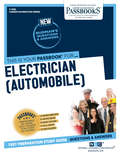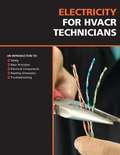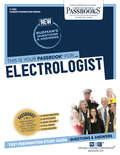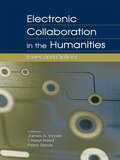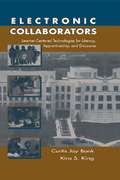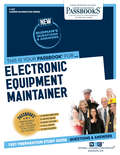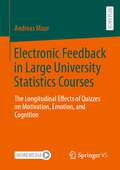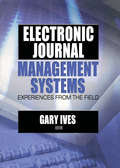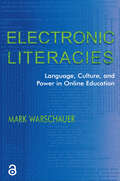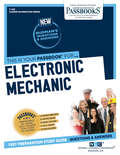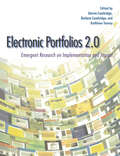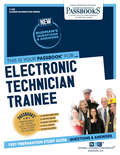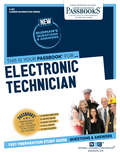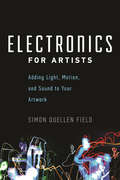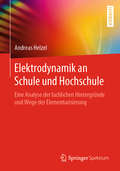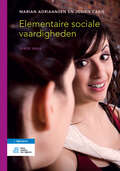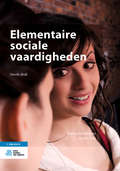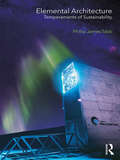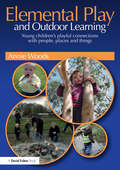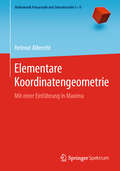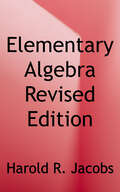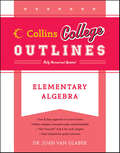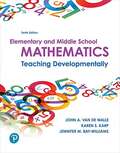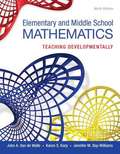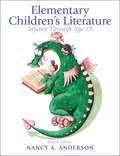- Table View
- List View
Electrician: Passbooks Study Guide (Career Examination Series #C-475)
by National Learning CorporationThe Electrician (Automobile) Passbook® prepares you for your test by allowing you to take practice exams in the subjects you need to study. It provides hundreds of questions and answers in the areas that will likely be covered on your upcoming exam, including but not limited to: trouble shooting, repairs, and maintenance of automotive ignition systems, electrical circuits, and battery and charging systems; proper use of hand tools, electrical meters, instruments, and accessories; knowledge of basic principles of electricity; techniques in record keeping, preparing reports and orders, supervising and training personnel; and more.
Electricity For HVACRTechnicians
by The Training AuthorityElectricity For Hvacr Technicians is a book that guides all its technicians through the need to know of electricity. It provides an introduction to safety, basic principles, electrical components, reading schematics, and troubleshooting.
Electrologist: Passbooks Study Guide (Career Examination Series)
by National Learning CorporationThe Electrologist Passbook® prepares you for your test by allowing you to take practice exams in the subjects you need to study. It provides hundreds of questions and answers in the areas that will likely be covered on your upcoming exam, including but not limited to: basic concepts of electricity, chemistry and human physiology; infection control; safety procedures; medical record keeping; and more.
Electronic Collaboration in the Humanities: Issues and Options
by James A. Inman Cheryl Reed Peter SandsThis volume provides an informed view of how information technology is shaping the contemporary humanities. It specifically reflects five ideals:*humanities scholars with all levels of access are doing important work with technology;*humanities scholars' projects with technology reflect significant diversity, both across and within disciplinary bounds;*using information technology in the humanities is a continuous conversation;*information technology offers new options for humanities education; and *just as collaboration changes the nature of any project, so does information technology change the nature of collaboration--its speed, character, methods, and possible implementations.The first to explore new and important ways for humanities scholars to collaborate across disciplines via electronic media, this book redefines electronic collaboration; presents insightful models of student collaboration; provides important models of faculty collaboration with special emphasis on professional development; and offers a look at the future of electronic collaboration and the overall future of the humanities. Featuring the voices of humanities teacher-scholars at all stages of their professional careers, the chapters emphasize pedagogy, outlining contemporary issues and options.Electronic Collaboration in the Humanities speaks directly to anyone involved with interdisciplinary initiatives in colleges and universities, such as writing across the curriculum and communication across the curriculum programs, and to specific populations within the humanities, including literacy and technology, language and literature, literacy studies, professional writing, and English education.
Electronic Collaborators: Learner-centered Technologies for Literacy, Apprenticeship, and Discourse
by Curtis Jay Bonk Kira S. KingTwo developments in recent years have converged to dramatically alter most conceptions of the teaching and learning process. First, technology has become increasingly interactive and distributed, such that individual learners have available the means to participate in incredibly complex networks of information, resources, and instruction. As these technological advancements facilitate interaction across classroom, university, and worldwide learning communities in both real-time and delayed formats, various instructional design and implementation problems spring forth. Second, the conventional teacher-centered model wherein knowledge is transmitted from the teacher to the learner is being replaced by social constructivist and learner-centered models of instruction. These new learner-centered models place emphasis on guiding and supporting students as they meaningfully construct their understanding of various cultures and communities. As a consequence of these developments, teachers need guidelines from educational researchers about integrating collaboration and communication tools into their classrooms. This volume presents research on such collaborative technology as it facilitates, augments, and redefines academic learning environments. The studies illustrate how schools, teachers, and students are discovering, employing, and modifying the numerous new computer conferencing and collaborating writing tasks and tools, and their effects on social interaction and resulting student learning. Documentation is given that will help teachers to make decisions that productively transform learning environments. Three key objectives underlie this volume: *to discover some of the electronic collaboration tools and formats currently employed by teachers in schools and universities and to situate these within a five-level taxonomy of computer conferencing and collaborative writing tools and approaches; *to examine some of the sociocultural learning variables embedded in the use of electronic collaborative tools and approaches; and *to participate in a dialogue about the importance of student electronic social interaction and dialogue from a sociocultural perspective. This is a must-read volume for all researchers, scholars, graduate students, and practitioners interested in such fields as sociocultural theory, process writing, cooperative learning, learner-centeredness, distance education, peer conferencing and tutoring, mentoring, electronic collaboration, problem- and project-based learning, collaborative writing, and educational reform.
Electronic Equipment Maintainer: Passbooks Study Guide (Career Examination Series #C-227)
by National Learning CorporationThe Electronic Equipment Maintainer Passbook® prepares you for your test by allowing you to take practice exams in the subjects you need to study. It provides hundreds of questions and answers in the areas that will likely be covered on your upcoming exam, including but not limited to: installation, diagnosis, maintenance and repair of complex electronic and electrical equipment, including communications equipment; the proper use of electronic testing equipment, hand tools, and other repair equipment; principles of the electronic and electrical trades; reading and interpreting schematics and technical manuals; relevant Federal Communication Commission rules, regulations and operating procedures; safe work practices and procedures in electronic and electrical repair shops; and more.
Electronic Feedback in Large University Statistics Courses: The Longitudinal Effects of Quizzes on Motivation, Emotion, and Cognition
by Andreas MaurDigital tools and pedagogies in public higher education are unfolding their potential by providing large groups of students with automated, continuous learning and feedback opportunities. However, most of the existing studies are cross-sectional, unidirectional and focus on a limited selection of relevant target variables and instructional features. In a field study, Andreas Maur used longitudinal latent structural equation modelling with a large sample of students to analyse the interrelations between formative feedback from electronic quizzes and different facets of the control value theory of achievement emotions. The results suggest that regular quizzes most consistently improve self-efficacy, anxiety, effort, course enjoyment, and hopelessness over time. Only feedback effects related to intrinsic motivation were consistently less effective for female and less proficient students, and for students in traditional versus flipped classrooms. These findings highlight the need to scale up formative feedback in higher education and to cultivate feedback systems with higher levels of sophistication, adaptability, and gamification mechanics.
Electronic Journal Management Systems: Experiences from the Field
by Gary W IvesDiscover how to manage your library&’s electronic journals-with tips from those who&’ve already met the challenge!The explosive growth of electronic journals presents unique challenges for libraries. Electronic Journal Management Systems: Experiences from the Field comprehensively examines these complex topics, including explanations of the automated systems libraries have developed or adopted, licensing issues, and the provision of access to electronic journals. Respected library professionals discuss their own experiences in the implementation and use of electronic journal management systems, helping readers to easily apply effective strategies in their own library.Electronic Journal Management Systems: Experiences from the Field reveals the available technologies, difficulties encountered, and successes of different librarians who met the challenge to implement management systems, giving readers an inside glimpse of what they themselves may encounter when planning their own system. The growth of electronic journals in libraries is addressed, along with helpful descriptions of management systems and link resolvers, including systems like SFX, Serial Solutions, TDNet, and EBSCO LinkSource. The book includes screen shots, tables, and diagrams to clearly illustrate concepts and information.Electronic Journal Management Systems: Experiences from the Field discusses a wide range of implementation and use issues, including: using Microsoft Excel to manage serial subscriptions better integration of management of electronic resources through library vendors one-stop serials management and access the selection process of a journal management system the preparation for implementation and subsequent transition process the Web site as a listing and finding tool the benefits of switching to an SFX environment creating a customized database for multiple systems the Innovative Interfaces, Inc. partnership with libraries to develop a module to manage electronic resources based on the work of the Digital Library Federation&’s Electronic Resources Management Initiative the evaluation and implementation process of a beta test library with an integrated library system vendor to develop a management system developing a universal management scheme for electronic resources Electronic Journal Management Systems: Experiences from the Field brings the latest strategies, technologies, and cutting-edge ideas to every library professional grappling with ways to manage the flow of electronic journals in a library.
Electronic Literacies: Language, Culture, and Power in Online Education
by Mark WarschauerElectronic Literacies is an insightful study of the challenges and contradictions that arise as culturally and linguistically diverse learners engage in new language and literacy practices in online environments. The role of the Internet in changing literacy and education has been a topic of much speculation, but very little concrete research. This book is one of the first attempts to document the role of the Internet and other new digital technologies in the development of language and literacy. Warschauer looks at how the nature of reading and writing is changing, and how those changes are being addressed in the classroom. His focus is on the experiences of culturally and linguistically diverse learners who are at special risk of being marginalized from the information society. Based on a two-year ethnographic study of the uses of the Internet in four language and writing classrooms in the state of Hawai'i--a Hawaiian language class of Native Hawaiian students seeking to revitalize their language and culture; an ESL class of students from Pacific Island and Latin American countries; an ESL class of students from Asian countries; and an English composition class of working-class students from diverse ethnic backgrounds--the book includes data from interviews with students and teachers, classroom observations, and analysis of student texts. This rich ethnographic data is combined with theories from a broad range of disciplines to develop conclusions about the relationship of technology to language, literacy, education, and culture. Central to Warschauer's discussion and conclusions is how contradictions of language, culture, and class affect the impact of Internet-based education. While Hawai'i is a special place, the issues confronted here are similar in many ways to those that exist throughout the United States and many other countries: How to provide culturally and linguistically diverse students traditionally on the educational and technological margins with the literacies they need to fully participate in public, community, and economic life in the 21st century.
Electronic Mechanic: Passbooks Study Guide (Career Examination Series)
by National Learning CorporationThe Electronic Mechanic Passbook® prepares you for your test by allowing you to take practice exams in the subjects you need to study. It provides hundreds of questions and answers in the areas that will likely be covered on your upcoming exam.
Electronic Portfolios 2.0: Emergent Research on Implementation and Impact
by Darren Cambridge Kathleen Blake Yancey Barbara CambridgeHigher education institutions of all kinds—across the United States and around the world—have rapidly expanded the use of electronic portfolios in a broad range of applications including general education, the major, personal planning, freshman learning communities, advising, assessing, and career planning.Widespread use creates an urgent need to evaluate the implementation and impact of eportfolios. Using qualitative and quantitative methods, the contributors to this book—all of whom have been engaged with the Inter/National Coalition for Electronic Portfolio Research—have undertaken research on how eportfolios influence learning and the learning environment for students, faculty members, and institutions.This book features emergent results of studies from 20 institutions that have examined effects on student reflection, integrative learning, establishing identity, organizational learning, and designs for learning supported by technology. It also describes how institutions have responded to multiple challenges in eportfolio development, from engaging faculty to going to scale. These studies exemplify how eportfolios can spark disciplinary identity, increase retention, address accountability, improve writing, and contribute to accreditation. The chapters demonstrate the applications of eportfolios at community colleges, small private colleges, comprehensive universities, research universities, and a state system.
Electronic Technician Trainee: Passbooks Study Guide (Career Examination Series)
by National Learning CorporationThe Electronic Technician Trainee Passbook® prepares you for your test by allowing you to take practice exams in the subjects you need to study. It provides hundreds of questions and answers in the areas that will likely be covered on your upcoming exam.
Electronic Technician: Passbooks Study Guide (Career Examination Series)
by National Learning CorporationThe Electronic Technician Passbook® prepares you for your test by allowing you to take practice exams in the subjects you need to study. It provides hundreds of questions and answers in the areas that will likely be covered on your upcoming exam, including but not limited to: arithmetic; knowledge of tools; workplace learning; systems troubleshooting; and more.
Electronics for Artists: Adding Light, Motion, and Sound to Your Artwork
by Simon Quellen FieldWith today's modern technology--LEDs, servomotors, motion sensors, speakers, and more--artwork can incorporate elements of light, sound, and motion for dramatic effects. Author and educator Simon Quellen Field has developed a primer for creative individuals looking for new ways to express themselves though electronically enhanced art. Following step-by-step examples of basic circuitry and programming, readers can develop the skills necessary to enhance their works of art. The book also features art projects to try, including a bouquet of glowing flowers, an LED metronome, a talking computer, a sensile robot, and a simple wheeled robot. A variety of artistic works created by Field's students and based on these open-ended lessons are also included to provide creative sparks for the readers. For those interested in programming their circuits, Field explores the basics of Energia, a free software package, and provides simple programs to create flashing light patterns, computer controlled motors, and LCD text displays.
Elektrodynamik an Schule und Hochschule: Eine Analyse der fachlichen Hintergründe und Wege der Elementarisierung
by Andreas HelzelDieses Lehrbuch analysiert die konzeptionelle Umsetzung und Stoffauswahl zur Elektrizitätslehre und Elektrodynamik an Schule und Hochschule und gibt einen reflektierten fachwissenschaftlichen Überblick, der die Entwicklung einer fach- und schülergerechten und anschlussfähigen Elementarisierung unterstützt. Jedes Kapitel gibt themenspezifisch zunächst einen Überblick der Inhalte für Schule und Hochschule. Dazu dienen Lehrpläne und Schulbücher der Sekundarstufe I und II sowie verschiedene Lehrbücher. Der Autor analysiert und diskutiert anschließend schulische und hochschulische Darstellungsweisen und Inhalte im Vergleich und stellt Elementarisierungsmöglichkeiten dar. Damit werden fachwissenschaftliche Inhalte auf schulischem und hochschulischem Niveau systematisiert, verglichen und diskutiert. Es geht dabei nicht um pauschale ideale Elementarisierungen, sondern es soll vor allem ein kritisch-reflexiver Blick auf fachwissenschaftlicher Ebene geschult werden. So unterstützt es bei der Gestaltung einer situationsspezifischen Elementarisierung, bezogen auf länderspezifische Lehrpläne, Jahrgangsstufe und konkrete Schülerschaft. Das Lehrbuch richtet sich an alle, die die Fachphysik lehramtsspezifisch reflektieren oder eine Elementarisierung gestalten möchten: Studierende, die ihr fachwissenschaftliches Studium im Kontext ihrer zukünftigen Profession sehen wollen, Lehrende, die einen derartigen Kurs anbieten und Forschende auf diesem Gebiet. Thematisch behandelt das Buch die üblichen Inhalte der hochschulischen Elektrodynamik und ihre Pendants in der Schule. Somit finden sich neben den Themen der Elektro-, Magnetostatik und Elektrodynamik auch Kapitel zu Optik (Beugung und Interferenz) und der speziellen Relativitätstheorie.
Elementaire sociale vaardigheden: Transferpunt Vaardigheidsonderwijs
by Marian Adriaansen Josien CarisCommuniceren is een belangrijk onderdeel van vrijwel elk beroep. Of communicatieprocessen effectief verlopen is niet alleen afhankelijk van aan te leren technieken, maar vooral ook van de 'echtheid' van iemands optreden. Om effectief te kunnen communiceren heb je (zelf)kennis nodig over je eigen kwaliteiten. Dit leermateriaal helpt je om de basisvaardigheden zo aan te leren dat zij kunnen dienen als solide basis voor de ontwikkeling van je specifieke beroepsvaardigheden. De auteurs besteden in de hoofdstukken op oriënterend niveau ook aandacht aan de toepassing van de basisvaardigheden in verschillende hulpverleningssituaties binnen welzijn en gezondheidszorg. Nieuw is de website met daarop een serie filmfragmenten waarin de besproken vaardigheden worden gedemonstreerd. Op deze website zijn ook toetsvragen, studieopdrachten en oefeningen opgenomen, die een actieve wijze van kennismaken met en oefenen van de beoogde vaardigheden mogelijk maken. Aan deze geheel herziene druk zijn twee nieuwe hoofdstukken toegevoegd: Argumenteren en Digitaal communiceren. Waar vele boeken vooral ingaan op de theorie, is dit boek ook erg praktijkgericht. Het geeft studenten goede handvatten om theorie toe te passen en te oefenen, waardoor het boek meer is dan alleen een verdiepend boek.
Elementaire sociale vaardigheden: Transferpunt Vaardigheidsonderwijs
by Marian Adriaansen Josien CarisDit boek helpt studenten in zorg en welzijn om communicatieve basisvaardigheden zó aan te leren dat die een solide basis vormen voor de ontwikkeling van specifieke beroepsvaardigheden. Ook leren ze om die communicatieve vaardigheden in verschillende hulpverleningssituaties toe te passen. Daarbij heeft het boek aandacht voor aan te leren technieken, én voor de echtheid van iemands optreden. Effectief communiceren vereist immers ook kennis over je eigen kwaliteiten. Elementaire sociale vaardigheden gaat uitgebreid in op de theorie, én is erg praktijkgericht. Het s een verdiepend boek, dat studenten handvatten geeft om theorie te oefenen en toe te passen. Aan deze geheel herziene druk is bovendien een nieuw hoofdstuk toegevoegd: omgaan met laaggeletterdheid. Ook nieuw is de mogelijkheid om met behulp van een app direct vanuit het boek de bijpassende filmfragmenten te bekijken. In deze filmfragmenten worden de besproken vaardigheden gedemonstreerd. Ze staan ook op mijn.bsl.nl - net als de toetsvragen, studieopdrachten en oefeningen. Zo kun je eenvoudig kennismaken met de beoogde vaardigheden, en ze actief oefenen.
Elemental Architecture: Temperaments of Sustainability
by Phillip James TabbElemental Architecture presents a new and refreshing approach to sustainable architectural practice. Going beyond the standard performance-based and quantitative sustainable measures, it incorporates a broader framework of considerations, including the more poetic and noetic possibilities of environmental design. The book is structured around the ancient Greek and medieval alchemists’ system of the Five Temperaments: fire, earth, air, water, and ether. Phillip James Tabb examines how these elements produce both positive and negative environmental forces which have an impact on architectural design – from drinking water and fresh air to torrential floods and tornados. He shows how responding to or enhancing these forces can help us to create a more sustainable, healthy, and purposeful architecture. To illustrate this, each chapter draws on seminal contemporary works of architecture, from Peter Zumthor’s Bruder-Klaus Field Chapel to Frank Lloyd Wright’s masterpiece at Fallingwater. These examples are accompanied by over a hundred high-quality illustrations. Expanding the discussion of sustainability to include phenomenological as well as qualitative considerations, Elemental Architecture is ideal for students and researchers with an interest in sustainable architecture and architectural theory.
Elemental Play and Outdoor Learning: Young children's playful connections with people, places and things
by Annie WoodsProviding a fresh approach to examining development in the early years, this book draws together well-established ideas and theories based on outdoor play experiences and connects them to spiritual development in children. Elemental Play and Outdoor Learning considers socio-cultural perspectives, guided participation and mediated learning alongside playfulness as it looks at young children’s developing interest in the people around them, the environment they experience and the ideas and objects that involve them. Including rich encounters with young children and adults, chapters cover: elemental play as an approach to observe and support children’s holistic development; the role of people in developing effective exploratory and social skills; using the concept of elemental play to consider the spiritual system as an aspect of child development; imaginative play with raw, natural materials and how prepared environments can encourage children’s natural exploration; an exploration of well-established constructs of play and how elemental play can be integrated or re-conceptualised with the other theories. Exploring current thinking about natural experiences, interest in forest school activity and fresh insight into dynamic ecological concepts, this book will be essential reading for practitioners and students on undergraduate and postgraduate early years and childhood studies courses.
Elementare Koordinatengeometrie: Mit einer Einführung in Maxima (Mathematik Primarstufe und Sekundarstufe I + II)
by Helmut AlbrechtDieses strukturell und didaktisch gut durchdachte Lehrbuch für die Ausbildung von Lehrerinnen und Lehrern im Fach Mathematik möchte den Studierenden die klassische Geometrie, die in der Schule leider ein Schattendasein fristet, unter einem etwas veränderten, neuartigen Blickwinkel nahe bringen. Von besonderem Reiz ist in diesem Zusammenhang die alte, ursprüngliche Descartes'sche Idee einer algebraischen Lösung geometrischer Probleme – ohne dabei die Geometrie durch den Formalismus der linearen Algebra und durch das Jonglieren mit Matrizen zu verdecken. Für die rechnerische Lösung der geometrischen Probleme sind nur einfache algebraische Verfahren nötig, wobei der gezielte Einsatz eines Computer-Algebra-Systems langwierige Berechnungen vermeidet und gleichzeitig die erworbenen Kenntnisse vertieft. Das Buch gibt hierfür eine praxis- und anwendungsbezogene Anleitung in den sinnvollen Gebrauch des Computer-Algebra-Systems Maxima. Eine vielfältige Aufgabensammlung rundet das Buch ab, Lösungen findet man kostenlos auf der Internetseite des Verlages.
Elementary Algebra
by Harold R. JacobsJacobs' best-selling Algebra 1 textbook has become a widely respected standard for teaching high school math in both top schools nationwide and within the homeschool market. <p><p>Jacobs' clear, engaging, conversational approach in Elementary Algebra utilizes real-world instruction and application, guiding your student towards developing a true understanding of Algebraic concepts-how they work, why they work, and how your student can apply them to everyday life!
Elementary Algebra (Collins College Outlines)
by Joan Van GlabekPrepared for students by renowned professors and noted experts, here are the most extensive and proven study aids available, covering all the major areas of study in college curriculums. Each guide features: up-to-date scholarship; an easy-to-follow narrative outline form; specially designed and formatted pages; and much more.
Elementary And Middle School Mathematics: Teaching Developmentally
by John Van de Walle Karen Karp Jennifer Bay-WilliamsThis handy reference is particularly useful for elementary teachers who are changing grade levels and special education teachers who teach multiple grades and multiple ability levels. Guide teachers to help all PreK-8 learners make sense of mathematics Elementary and Middle School Mathematics: Teaching Developmentally illustrates how children learn mathematics, and then shows pre-service teachers the most effective methods of teaching PreK-8 math through hands-on, problem-based activities. As you engage with the activities, you'll boost your own knowledge of the math and learn concrete, developmentally appropriate ways to incorporate problem-based tasks in your classroom. Examples of real student work and new common challenges and misconception tables help you visualize good mathematics instruction and assessment that supports and challenges all learners. An important reference to consult throughout your teaching career, this book reflects the Common Core State Standards and NCTM’s Principles to Actions, as well as current research and coverage of the latest teaching technology.
Elementary And Middle School Mathematics: Teaching Developmentally
by John A. Van de Walle Karen S. Karp Jennifer M. Bay-WilliamsElementary and Middle School Mathematics: Teaching Developmentally, Professional Development Edition provides unparalleled depth of ideas and discussion to help mathematics coaches and other teacher leaders foster teachers' understanding of the mathematics they will teach and the most effective teaching methods for the various mathematics topics. This text reflects the philosophy of the NCTM and Common Core State Standards and the benefits of problem-based mathematics instruction. The Coach/Teacher Leader Guide to this Book and Activities Matrix that appear at the front of the book and Professional Learning Opportunities sections, Coach/Teacher Leader Considerations boxes, and PDToolkit boxes that appear at the end of each chapter ensure this book is a valuable resource for all educators who facilitate mathematics professional development and support students making sense of mathematics.
Elementary Children's Literature: Infancy Through Age 13
by Nancy A. AndersonThis widely popular book is organized around genres, including a complete chapter on each major genre plus a full chapter for each of the four subgenres of fiction. The teaching strategies, technology applications, coverage of culturally diverse literature, and instructional tie-ins are of immediate use to teachers and parents. Included in each genre chapter are bibliographies of exemplary books in print, multiple annotations, and evaluation criteria for the genre. The author writes in a conversational tone and defines each literary and educational term in the text the first time it is used, and then reinforces the meaning in a useful end-of-book glossary. <P><P> The extensive coverage of culturally diverse literature found throughout the book is supplemented by an excellent chapter (8) on culturally diverse literature written by minority literature specialists who give readers an insider's view of their cultures and provide annotated lists of books by (not just about) minority authors and illustrators. This, coupled with the many instructional ideas woven throughout the book, and the final chapter, "Teaching Reading through Literature," helps teachers and parents apply their knowledge of literature to help children grow in their language and reading abilities.
